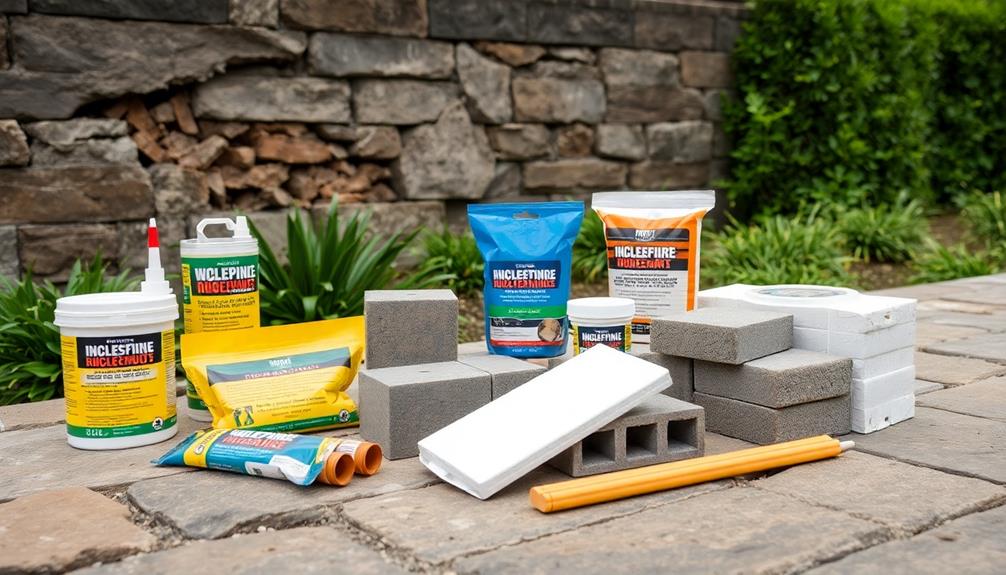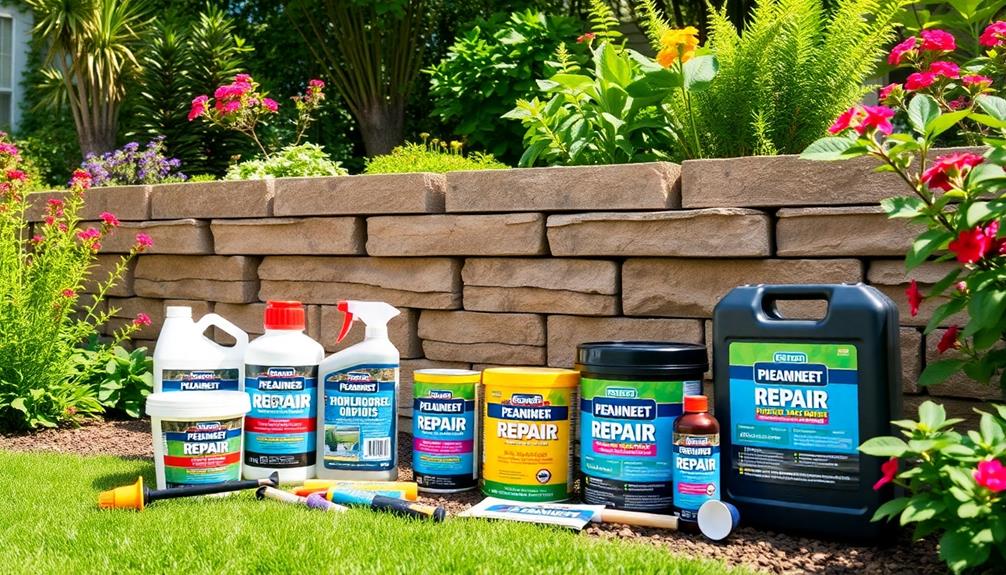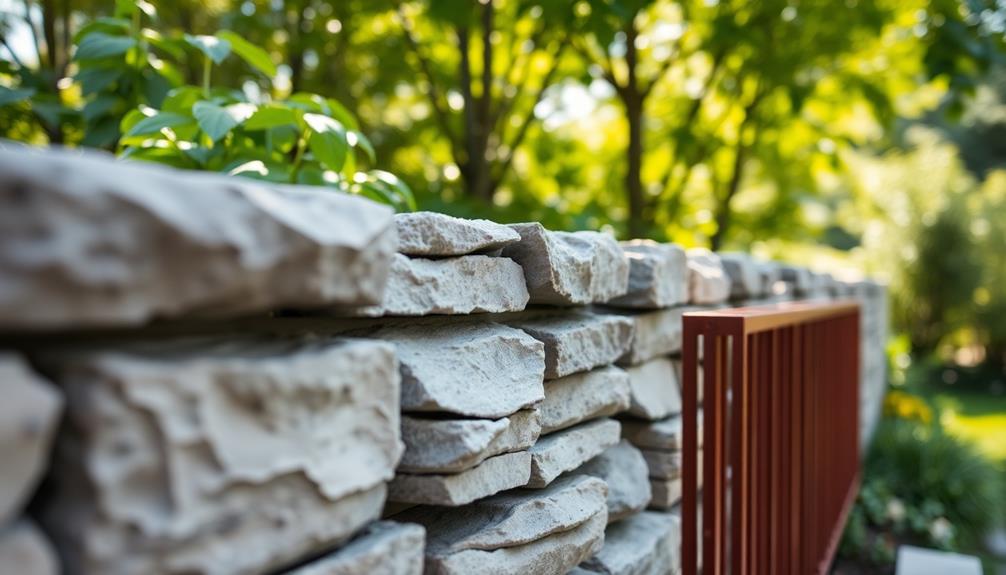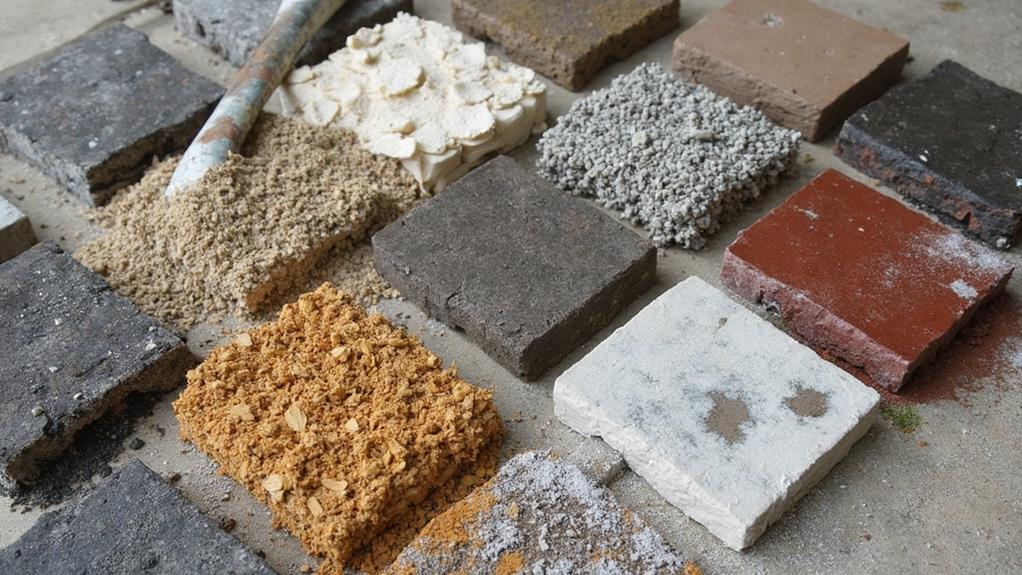For effective retaining wall repair, selecting top-quality products guarantees both aesthetic improvement and enhanced structural stability. Key products include high-strength epoxy resins ideal for crack repairs and stone veneer panels for visual enhancement. Geogrid reinforcement fabrics are essential for maintaining stability by preventing soil erosion, while concrete repair mixes fortified with polymers offer superior adhesion and elasticity. Weather-resistant materials like polyurethane sealants provide long-term protection against environmental wear, aiding in the prevention of erosion, bowing, or wall failure. These specialized repair products are integral for prolonging wall lifespan and maintaining integrity, promising insights into ideal long-term solutions.
Table of Contents
ToggleWalls Contractor Highlights
- Epoxy resins are praised for excellent adhesion and water resistance, stabilizing cracks and preventing further damage.
- Concrete repair mixes with polymers enhance strength, flexibility, and longevity in various environmental conditions.
- Geogrid reinforcement fabrics are highlighted for their ability to stabilize soil and prevent erosion effectively.
- Stone veneer panels and textured finishes improve aesthetics and seamlessly integrate with existing structures.
- Cost-effective soil nailing reinforces weakened walls, providing additional stability without needing full replacement.
Definition of Retaining Wall Repair

The purpose of retaining walls is to hold back soil and prevent erosion, yet over time, they can encounter structural fatigue and environmental wear, necessitating precise repair solutions.
Specific types of retaining walls, like Limestone Retaining Walls, offer unique challenges due to their material composition. Addressing common repair challenges such as cracking, bulging, and leaning is pivotal to restoring a wall's functionality and stability.
Essential repair materials, ranging from high-strength concrete mixes to specialized wall anchors, are fundamental in ensuring the durability and effectiveness of repair tasks.
Purpose of Retaining Walls
Serving both functional and aesthetic purposes, retaining walls are indispensable structures in landscape architecture and civil engineering. They are designed to hold back soil, thereby preventing erosion and managing slopes. These walls provide stability, effectively transforming challenging terrain into usable spaces.
As the backbone of landscaped areas, retaining walls contribute to environmental resilience, offering crucial support in flood and landslide-prone regions. Their purpose extends beyond mere functionality, as they enhance the visual appeal of outdoor spaces, blending seamlessly into the surrounding environment.
A well-constructed retaining wall serves multiple objectives, including:
- Erosion Control: Protecting landscapes from the damaging effects of water runoff, retaining walls minimize soil loss.
- Slope Management: Allowing the creation of level surfaces on steep gradients, they improve land usability for agriculture and construction.
- Aesthetic Enhancement: Serving as design features that add character, texture, and dimension to landscaping projects.
- Structural Support: Providing essential reinforcement to weak and sloped grounds, ensuring structural integrity and safety.
Common Repair Challenges
Retaining walls play a pivotal role in both functional and aesthetic landscaping, but like all structures, they are not impervious to wear and tear. As the structural backbone of terraced landscapes and sloped gardens, retaining walls face numerous challenges over time.
Water intrusion is among the most prevalent issues, often seeping through improperly sealed joints or cracks, leading to erosion and ground shifting. This not only undermines the wall's stability but also fosters unsightly mildew and mold growth which can be detrimental to the aesthetic integrity of the landscape.
Further compounding these issues is soil pressure, a silent yet relentless force that can lead to wall bowing or leaning, potentially resulting in catastrophic failure if unaddressed. Freeze-thaw cycles contribute extensively to the deterioration as well, causing materials to expand and contract, prompting fractures that invite further elemental damage. Inadequate drainage exacerbates these problems, cultivating conditions that promote hydrostatic pressure against the wall structure.
Proper diagnosis and timely intervention are quintessential for mitigating these challenges and ensuring the longevity of retaining walls. By understanding these common repair challenges, homeowners and property managers can better appreciate the complexities involved and take informed steps toward maintaining the structural and visual harmony of their environments.
Essential Repair Materials
Addressing the repair needs of retaining walls requires a thorough understanding of essential repair materials, each selected for its specific ability to restore structural integrity and aesthetic appeal. These materials form the backbone of successful rehabilitation projects by ensuring durability and the seamless integration of restored sections with existing structures. Knowledgeable selection and application can greatly extend the lifespan of your retaining wall, safeguarding both the investment and the landscape it serves.
Essential repair materials include:
- Concrete Repair Mixes: Designed to repair cracks and surface spalling, these materials often come with polymers to enhance adhesion and elasticity, providing strength and resilience while blending with existing concrete.
- Geogrid Reinforcement Fabrics: Promoting stability and preventing further soil erosion, geogrids are incorporated into the soil surrounding retaining walls, ensuring enhanced load-bearing capacity and structural cohesion.
- Epoxy Resins: Particularly suitable for binding cracks and enhancing water resistance, epoxy resins deliver robust adhesion and strength, ideal for environments exposed to varying moisture levels.
- Stone Veneer Panels: Used to restore or enhance the visual appeal by covering the face of retaining walls with natural or cast stones, these panels offer a pragmatic solution for both protection and aesthetic enhancement.
Benefits

Utilizing top retaining wall repair products provides an array of benefits, including the enhancement of structural stability and the extension of the wall's lifespan, ensuring safety and durability over time. These products are durable and weather-resistant, making them suitable for various environmental conditions while maintaining the integrity of the retaining walls.
Such products also offer aesthetic improvement options, enabling property owners to achieve an appealing appearance without compromising functionality. Additionally, these solutions are often cost-effective, providing a practical alternative to full wall replacements while minimizing long-term maintenance expenses.
Enhanced Structural Stability
A well-maintained retaining wall acts as a cornerstone for enhanced structural stability in any landscape or construction project. Retaining walls that are repaired with high-quality products not only assure ideal performance but also safeguard the integrity of the entire site. The use of superior repair materials fosters an environment where balance and durability are prioritized, accommodating not just the immediate needs but also investing in long-term stability.
Effective retaining wall repair involves:
- Increased Load-Bearing Capacity: Robust materials can handle greater weight, effectively supporting soil and other structural pressures.
- Improved Resistance to Environmental Strain: Quality repairs mitigate the adverse effects of weather conditions, such as erosion or heavy rainfall, ensuring permanency.
- Enhanced Aesthetic Appeal: Well-repaired walls contribute to an inviting and cohesive look, reinforcing a sense of community and belonging.
- Prevention of Structural Failures: Minimizing risk of collapses and associated damages allows for a safer, more secure environment.
Engaging with top retaining wall repair products means adopting practices that honor both safety and aesthetics. This convergence of structural stability and visual appeal is critical for any community seeking durability and resilience in its infrastructure, cultivating spaces that stand the test of time and create a foundation for shared experiences.
Prolonged Wall Lifespan
Building upon enhanced structural stability, the benefits of prolonging a wall's lifespan become evident through the use of top-tier repair products. When a retaining wall continues its service for extended periods, it provides not only sustained support for land but also reassures property owners of their investment's durability.
Over time, environmental factors relentlessly test these structures. However, premium repair solutions, equipped with advanced materials and technologies, fortify the wall's resistance against such wear and tear, ensuring its prolonged functionality and appearance.
The deployment of specialized repair products plays a pivotal role in extending the life of a retaining wall. By addressing issues at their core, such products hinder the progression of minor defects into significant structural damages. In addition, they exhibit excellent adhesion and flexibility, maintaining the wall's integrity even under fluctuating conditions.
For communities relying on shared spaces, the longevity of these walls fosters a sense of unity and collective security, strengthening neighborhood ties. Furthermore, utilizing top-grade repair options marks a strategic approach to sustainability. It minimizes waste by reducing the need for frequent replacements, thereby conserving resources. Ultimately, these benefits directly contribute to the enduring safety and soundness of a cherished shared environment.
Aesthetic Improvement Options
Enhancing the visual appeal of retaining walls is a pivotal aspect that complements their structural function. Beyond the fundamental roles of supporting soil and preventing erosion, retaining walls can transform landscapes by adding elements of beauty and sophistication. Aesthetic improvement options bring both charm and cohesion to environments, allowing homeowners and communities to cultivate spaces that resonate with their identity and aesthetic preferences.
A variety of solutions are available to enhance the beauty of retaining walls, taking into account both material selection and design features:
- Textured finishes: Implementing varied textures such as stone veneers or stamped concrete can add depth and character, providing a unique touch to each wall.
- Coloration techniques: Utilizing stains or paints specifically designed for masonry surfaces can blend the wall seamlessly with surrounding landscapes or create vibrant focal points.
- Integrated lighting: Carefully planned lighting can illuminate walls after dusk, highlighting architectural features and adding an inviting ambiance to gardens and yards.
- Incorporation of greenery: Integrating plant pockets or climbing vines into the wall structure adds a natural element that changes dynamically with the seasons and provides ecological benefits.
These aesthetic enhancements not only serve to beautify retaining walls but also foster a sense of community and pride among residents, reflecting shared values and taste.
Cost-Effective Repair Solutions
While aesthetic enhancements can greatly elevate the appeal of retaining walls, their foundational integrity must not be overlooked. Cost-effective repair solutions serve as a key aspect of maintaining a structurally sound and visually appealing landscape feature. There exists a spectrum of affordable repair options, each offering distinct advantages that safeguard the longevity and reliability of your retaining walls.
Firstly, epoxy injections present a cost-efficient method to fill and stabilize minor cracks, effectively binding the wall material back together without an invasive overhaul. These injections enable swift restoration while substantially extending the lifespan of the structure.
Another viable option includes geogrid reinforcements, which enhance wall stability by distributing loads evenly. This approach is particularly beneficial for retaining walls experiencing extensive pressure or soil movement but does not require a full-scale reconstruction, consequently reducing costs.
For those mindful of budget constraints, soil nailing provides a robust technique to fortify existing walls. By installing steel tendons or similar materials into the soil behind a weakened wall, soil nailing enhances wall support at a fraction of the price of complete wall replacement. These pragmatic solutions collectively emphasize the importance of a cost-conscious yet thorough approach to retaining wall repair, ensuring safety and durability without compromising fiscal prudence.
Weather-Resistant Material Options

When considering weather-resistant material options for retaining wall repairs, it is essential to focus on solutions that provide long-lasting protection against harsh environmental conditions. The combination of durable coating solutions, high-strength adhesives, and UV protection features guarantees that repairs withstand both time and exposure. Below is a table highlighting these key material options:
| Material Feature | Benefit | Typical Use |
|---|---|---|
| Durable Coating | Resists moisture | Surface protection |
| High-Strength Adhesive | Enhances structural integrity | Bonding and fixing |
| UV Protection | Prevents discoloration | Exposed areas |
| Weather Sealant | Prevents leaks | Joints and seams |
| Anti-Fungal Additive | Inhibits mold growth | Damp environments |
These strategically integrated features enable retaining walls to maintain their functionality and aesthetic appeal, even in extreme weather conditions.
Durable Coating Solutions
Selecting durable coating solutions is crucial for ensuring a retaining wall's longevity and effectiveness. These coatings serve as a protective shield against the elements, preventing moisture ingress and physical wear that could compromise the structure's integrity. Additionally, they provide an opportunity to enhance the visual appeal of the wall, contributing to its aesthetic integration within the surrounding environment. By choosing the right durable coating, you can fortify your retaining wall against common threats like rain, wind, and UV radiation, ensuring its functionality and durability for years to come.
To help you make an informed decision, consider the following weather-resistant material options:
- Acrylic coatings: Renowned for their flexibility and resistance to cracking, these coatings allow for easy application and maintenance, ensuring the wall adapts to environmental changes.
- Polyurethane coatings: Offering exceptional abrasion resistance alongside stunning UV protection, they are ideal for structures exposed to harsh sunlight.
- Epoxy coatings: Known for their strength and chemical resistance, these coatings create a robust barrier against water and environmental contaminants.
- Silicone coatings: With superior heat and cold resistance, silicone coatings are suitable for walls facing fluctuating temperature conditions.
Selecting the appropriate coating solution will safeguard your investment while enhancing the overall appearance of your retaining wall.
High-Strength Adhesives
Utilizing high-strength adhesives is a strategic approach in reinforcing the structural stability of retaining walls, especially in environments subject to dynamic weather conditions. As structures that fundamentally resist lateral pressure, retaining walls must endure various stressors, not least of which are temperature fluctuations, precipitation, and freeze-thaw cycles. High-strength adhesives provide an essential solution, binding wall components firmly, thereby reducing the risk of structural failure and enhancing durability.
These adhesives are formulated to withstand the diverse challenges posed by harsh climates. Many are designed with superior bonding capabilities that penetrate surfaces and maintain pliability, guaranteeing resilience under different thermal conditions. They often exhibit excellent moisture resistance, a significant feature in preventing water infiltration, which can lead to deterioration of the structural integrity of the wall.
Additionally, high-strength adhesives contribute to the efficiency of repair processes by minimizing curing times and allowing for immediate load-bearing. This feature guarantees that maintenance is not only effective but also expedient, a fundamental factor for those maintaining large-scale or critical infrastructure. Consequently, selecting suitable adhesives provides assurance to property owners and maintenance crews, fostering a sense of security and community by safeguarding shared spaces.
UV Protection Features
A critical aspect of maintaining the longevity and aesthetic appeal of retaining walls is the incorporation of UV protection features into repair materials. Exposure to UV radiation can lead to the degradation of many materials, causing discoloration and weakening their structural integrity over time. Weather-resistant material options, as a result, play a pivotal role in ensuring the durability and visual coherence of retaining walls. Selecting products specifically designed with superior UV resistance can extensively prolong the lifespan of these structures and maintain their original vibrancy.
When evaluating potential repair products, consider those that offer robust UV protection through various mechanisms, such as:
- Pigment-Saturated Coatings: Designed to reflect harmful UV rays, these coatings maintain wall integrity.
- Polyurethane-based Sealants: Known for flexibility and high resistance, these sealants shield against UV damage while providing superior adhesion.
- Enhanced Concrete Additives: Some additives are engineered to bolster concrete's natural resistance to UV radiation, increasing longevity.
- Innovative Polymers: Polymers with built-in UV inhibitors protect underlying materials from sun damage, ensuring lasting performance.
Each of these material selections contributes to a broader agenda of sustainability and conservation within construction practices. By incorporating these protective features, homeowners and landscapers alike can enjoy visually pleasing, resilient retaining walls that seamlessly blend into their environment.
Walls Contractor FAQ
What Are the Common Signs That a Retaining Wall Needs Repair?
Common indicators that a retaining wall requires repair include visible cracks, leaning or bulging structures, water pooling at the base, gaps between stones or blocks, and soil erosion behind or alongside the wall. Addressing these signs guarantees stability.
How Can I Estimate the Cost of Repairing My Retaining Wall?
Estimating the cost of retaining wall repair involves gauging the damage extent, wall size, material type, and labor costs. Consulting with experienced professionals secures accurate evaluations, fostering informed decision-making and facilitating a strong, lasting community environment.
Are There Eco-Friendly Options for Retaining Wall Repairs?
Eco-friendly retaining wall repair options are available, incorporating recycled materials and sustainable practices. Techniques like using permeable concrete or natural stone not only promote environmental health but also enhance your property's aesthetic, fostering a sense of community harmony.
How Long Do Typical Retaining Wall Repair Products Last?
Typical retaining wall repair products generally last between 5 to 20 years, depending on factors such as material quality, environmental conditions, and maintenance. Opting for high-quality solutions fosters community trust and guarantees structural stability over time.
Can I Use DIY Kits for Retaining Wall Repairs, and Are They Effective?
DIY kits for retaining wall repairs can be effective for minor damage when paired with the right skills and attention to detail. However, for extensive repairs, professional intervention guarantees structural integrity, consequently fostering a sense of community trust.







